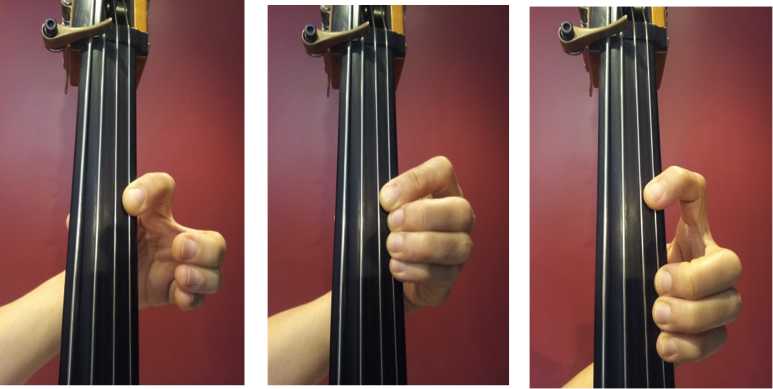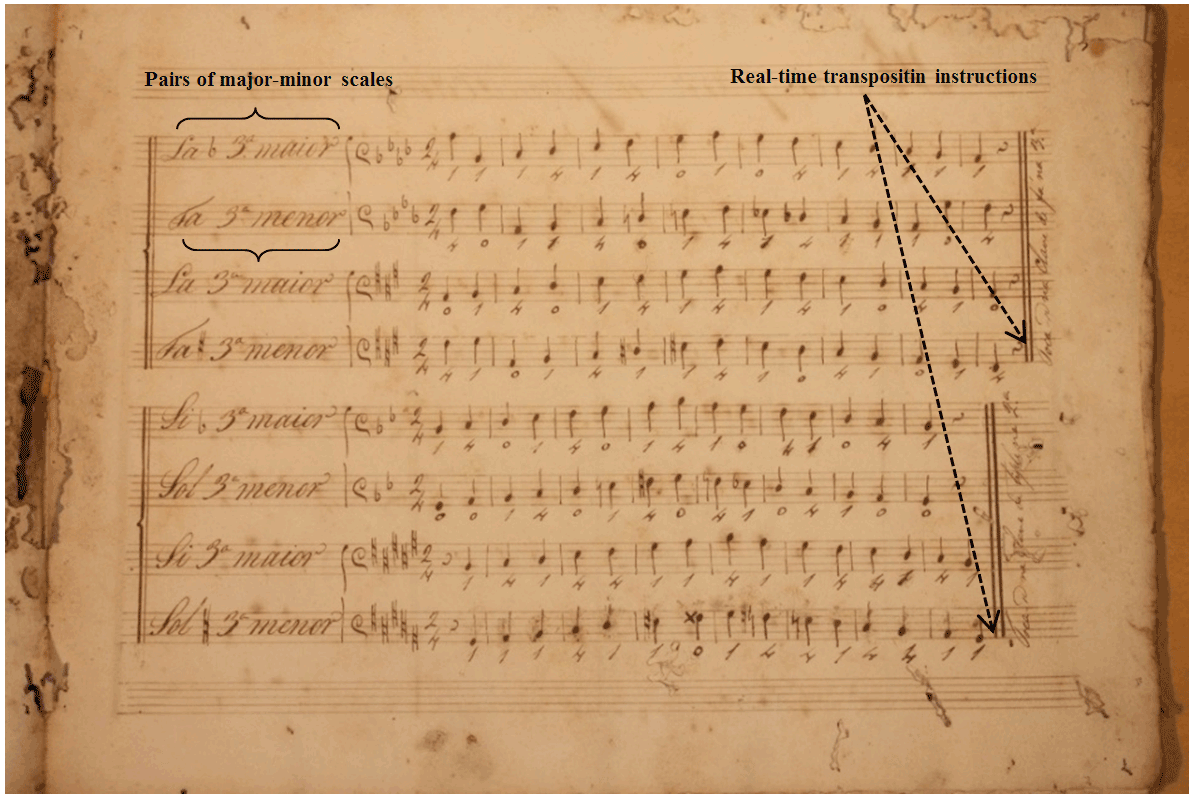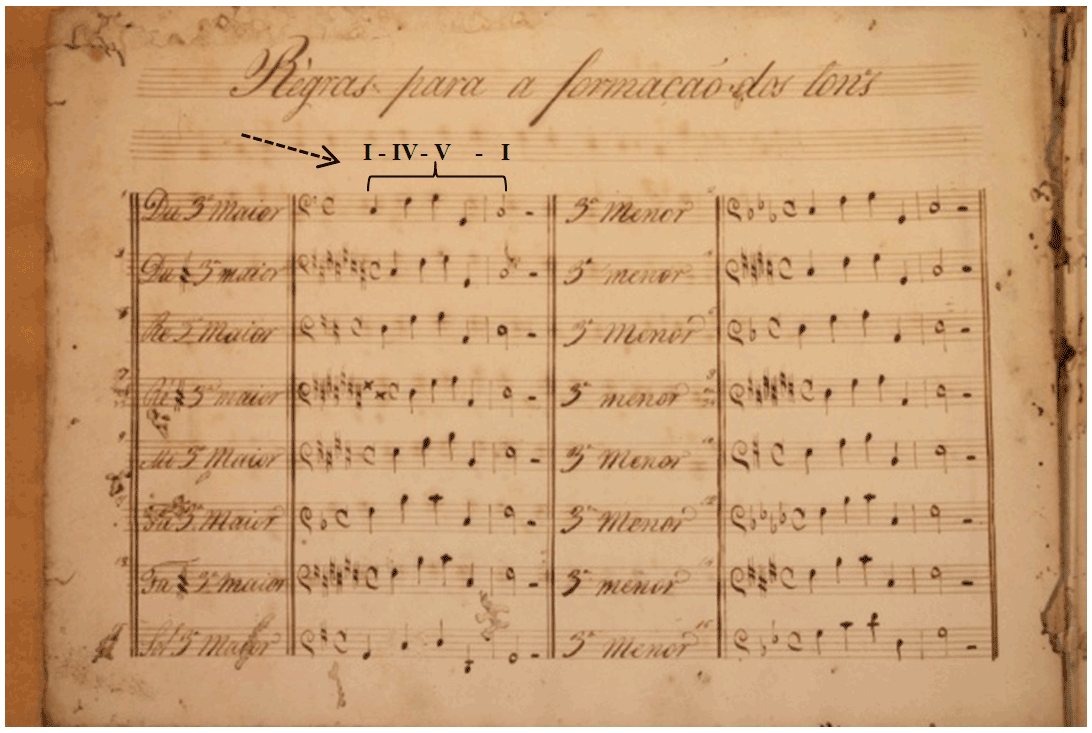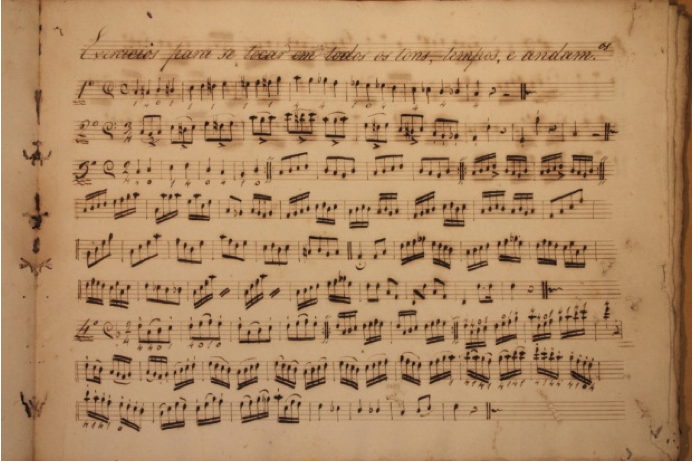| |
Volume 5, April 2015
Lino José Nunes's 1838 Methodo : Historical, Analytical and Editorial aspects of an Afro-Brazilian Double Bass Jewel
by Fausto Borém, Alfredo Ribeiro, Gustavo Neves, João Paulo Campos, and Rodrigo Olivarez
2. Part I of the Methodo: Double bass performance practices in Imperial Brazil
The physical difficulties associated with playing the double bass can be appreciated in Italian bass pedagogue Isaia Billè's own 1890 poem, published as an epigraph of his seminal book, Nuovo metodo per contrabasso a 4 e 5 cordes. He mentions " . . . thy thick and hard strings . . . " (" . . . tue grosse e dure corde . . . ") that ineptly played, resulted in " . . . grotesque voices and so deaf notes . . . " (" . . . grottesche voci e note tanto sorde . . . ") (Billè, 1922, p.117). Raymond Elgar (1987, p.74), in the first book of his trilogy dedicated to the double bass, Introduction to the double bass, reports that one of the gut strings of the Paris Conservatory's octobass has a diameter of half an inch (1,27 cm)! Elgar (1987, p.105) also talks about historical double bass methods and mentions the "fistcuff"(or "fisticuff") fingering, the firm and tight grip of the left hand on the double bass neck that the bassist resorted to when dealing with the difficulty of pressing down the strings.11 As the name suggests, the "fistcuff" has only two options: the open position (played with finger 1) or the closed position (played with finger 4 to which fingers 2 and 3 were added). The closed position was used for both half step (indicated by the lower case "m" indicating a "minor" second) and whole step departing from finger 1 (indicated by the capital "M" indicating a "major" second) to play, for example, the notes A3, A#3, (or Bb3) and B312 as shown in Ex.2.
 Ex.2 — The "fistcuff" fingering: notes A3 with finger 1, A#3 with finger 4 ("minor" position) and B3 with finger 4 ("major" position) based in Elgar's description in Introduction to the double bass (1987, p.105).
In vol.4 of his 7-volume method, Marangoni (1929, p.42) mentions the "Babylon" of fingerings for the double bass: " . . . after almost 300 years of its first presence in the orchestra, there is not a single fingering system, as it happens with the other instruments of its family". He presents a synoptic table of what seems to be the most influential double bass schools in Italy. There we can infer that a common limitation in double bass construction at that time was the excessive string tension near the nut, as fistcuffs were common in Europe. He also brings the surprising information that this technique was used by various double bass icons of the double basses tuned in perfect 4ths: Dragonetti (when playing B2-C3 on the A-string or E3-F3 on the D-string), Bottesini (when playing B2-C3 on the A-string, E3-F3 on the D-string or B3-C4 on the G-string) and even Simandl (when playing F#2-G2 on the E-string) In his method, J. Fröhlich (1829) gives the "fistcuff" fingering a different name — "clamp" — from which we can also infer the dual-only use of the left hand fingers. However, he advocates the substitution of finger 4 by finger 3 in higher positions, where the strings are more flexible. The practice of "fistcuff" was in use in Brazil in the 19th century and is documented in Nunes's "Methodo".
Lino José Nunes's "Methodo"is divided in two larger parts. Part I, devoted to the double bassist's preparatory daily practice, is subdivided into three smaller sections. Section A (Nunes, 1838, pp.2-5, Ex.3), named as "Escalas para o contrabaxo de tres cordas afinado em quartas" ("Scales for the 3-stringed double bass tuned in fourths"). Before the scales, Nunes provides three preparatory elements. The first element is a scalar diatonic A minor scale, from A2 to G4, covering the whole orchestral tessitura of the 3-stringed bass explored in his "Method". In this scale, while the symbols "o", "1" and "4" over the notes reveal the "fistcuff" fingering system, the word "3ª corda" ("3rd string") under the first notes indicates the string for the notes to be played on. The highest note in the "Method ," a G4, suggests orchestral bassists in Brazil did not know the capo tasto technique and possibly employed the practice of leaving gaps in the bass line (or transposing it one octave down) when facing notes such the G#4 and A4, very common for the cello's 1st string.13 On the other hand, the lowest note, A2, confirms the most common double bass used in Brazil, the 3-stringed double bass tuned in 4ths. Secondly, Nunes presents the "Signos de transporte" (Transposing signs), constituted by whole-note pairs to illustrate, at the same time, the reading notes and the corresponding actual notes. Thirdly, Nunes introduces a chromatic scale in quarter notes from A2 to C3, where symbols for the index and "pinky" fingers suggest again the "fistcuff" fingering and, probably, the only one known (or at least documented) in Brazil.
 Ex.3 - Range of the "Brazilian" double bass (A2 to G4), the "fistcuff" fingering system, string designation, the octave transposition and the chromatic scale (Nunes's Methodo, Part I, Section A, p.2).
But there is a discrete piece of information in the "Methodo" that suggests another type of double bass in use in Brazil in the first half of the 19th century. When Nunes provides the G major (p.4) and G minor (p.5) scales with their respective fingerings, he places the symbol "o" (the small circle symbol that represents open strings) above the notes G2, A2, D3 and G3 (Ex.4), which points to the 4-stringed double bass with its 4th string tuned just a major second below the 3rd string. The reason behind it is probably the difficulty to manufacture strings to go that deep. This tuning is mentioned by Brun (1982, p.181) in Nicolai's 1816 bass method, by Planyavsky (1998, p.121), and much earlier in a treatise by Thomas Baltazar Janowka in 1715. The possibility for a 3-stringed double bass tuned G2 - D3 - G3 "à l'italienne", according to Brun (1982, p.168) seems improbable due to the four open string symbols in Nunes's manuscript. But those are the only instances Nunes mentions the low G2, which points to the existence of 4-stringed basses in Brazil, in spite of the apparently massive predominance of 3-stringed instruments.
 Ex.4 — Open string symbols ("o") in the G major (p.4) and G minor (p.5) scales suggest the use of the 4-stringed double bass tuned to G2-A2-D3-G3 in Imperial Brazil (Nunes's Methodo, Part I, Section A, pp.4-5).
Nunes provides pairs of one-octave scales in major keys (C major - C flat major etc.) followed by their relative minor keys (A minor - A flat minor etc.). For each group of four scales, there are instructions written vertically for the practice of transposition in various ways. For example, on p.3 (Ex.5), at the end of the top system is written "Toca-se na clave de Fá na 3ª [linha]" ("To be played in the bass clef in the 3rd [line]"), while at the end of the bottom system is written "Toca-se na clave de tiple na 2ª [linha]" ("To be played in the "tiple" [the choir´s sopranino boy] clef in the 2nd [line]"). These indications suggest that the skill to transpose in real time (i.e., during the performance) was in demand in Imperial Rio, a city known to receive famous Italian opera divas and castrati.
Ex.5 — Major and minor scales in all tonalities followed by instructions for real time transposition in various clefs (Nunes's Methodo,Part I, Section A, p.2).
Section B of Part I in the "Methodo" (Nunes, 1838, pp.6-7, Ex.6) is called "Règras para a formação dos tons" ("Rules for the establishment of tonalities"; pp.6-7) and presents cadential formulas, which bassists should learn in order to realize the I-IV-V-I harmonic progression in all major and respective minor homonymous keys. Pedagogically, these formulas seem to be connected with the performance practice of accompanying singers who need to change the key of the music, such as in an operatic solo.
Ex.6 — Cadential formulas for the orchestral bassist to be able to accompany in all keys (Nunes's Methodo, Part I, Section B, p.6).
As its name suggests, Section C of Part I in the "Methodo" (Nunes, 1838, pp.8-9, Ex.7), "Exercicios para se tocar em todos os tons, tempos e andam." ("Exercises to be played in all tonalities, tempi and character"; pp.8-9) aims at providing the double bassist with the flexibility required in the most common operatic and symphonic repertory: duple, triple and quadruple meter, chromaticism, ornaments, scales and arpeggios, syncopations with off-beat accents, diverse articulation (2, 3 and 4-note slurs, staccato, marcato), etc.
Ex.7 — Exercises in all keys, tempi and character for the flexibility of the double bassist (Nunes's Methodo, Part I, Section C, p.8.).
|
|






